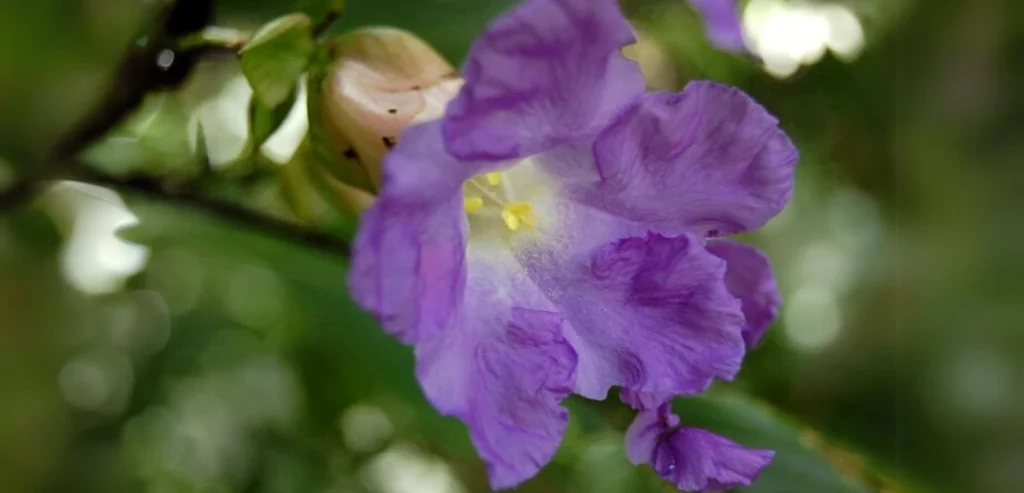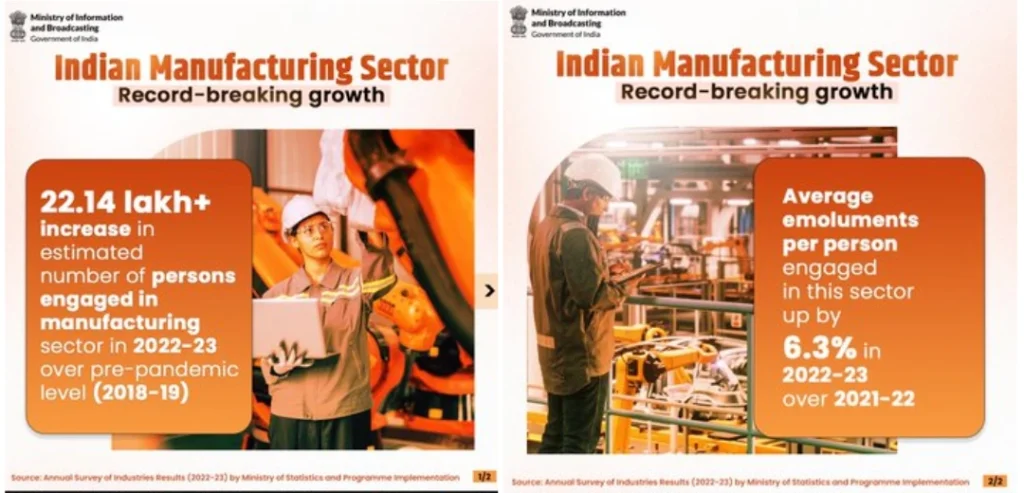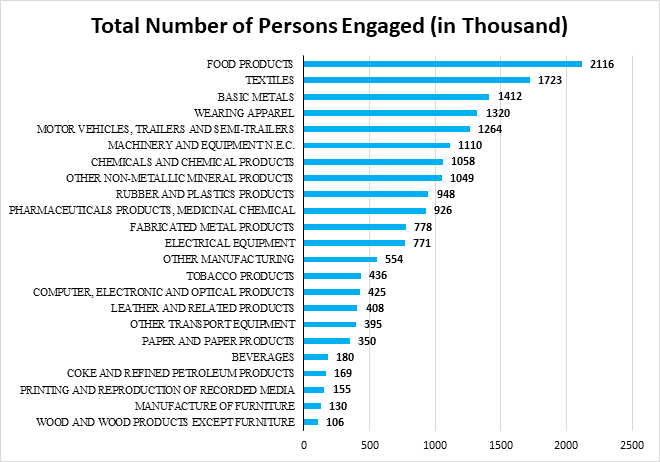1. Karvi Flowers (PRELIMS – ENVIRONMENT)

Strobilanthes callosa
Botanical name: Strobilanthes callosa Nees (= Carvia callosa (Nees)Bremek., Strobilanthes grahamianus, White, = Ruellia callosa Wall.) Vernacular name: Karvi Family: Acanthaceae
Threatened category: Low risk
Flowering and fruiting: September-June.
Distribution: India – Endemic to W. Peninsular India and central India, in the states of Maharashtra, Madhya Pradesh, Gujarat and Karnataka.
This plant flowers at the interval of 7 to 8 (Sometimes 10) years.
Its standardised Hindi language name is Maruadona by which it is called in the state of Madhya Pradesh
In the state of Maharashtra in the Marathi language and other local dialects and in the neighboring state of Karnataka the shrub is locally known as Karvi, sometimes spelled in English as Karvy.
Uses
- Leaves have astringent(An astringent is a substance that draws water out of tissues, causing them to shrink. In skin care, using astringent products after cleansing can temporarily tighten the skin, shrink pores, and remove oil.), Diuretics (a drug that increases the flow of urine. Diuretics promote the removal from the body of excess water, salts, poisons), and lithontriptic properties(relating to destroying bladder or kidney stones).
- The plant has been the subject of scientific research which confirms its use in folk medicine as a valid anti-inflammatory and antimicrobial herbal drug with anti-rheumatic activity.
- Used by the local Adivasi tribals and villagers as thatching material to build their huts.
2. Enforcement Directorate (PRELIMS – POLITY & GOVERNANCE)
Why in News?
Karnataka CM booked by ED in probe linked to Mysuru land allotment.

The Enforcement Directorate booked Karnataka Chief Minister Siddaramaiah in a money-laundering case linked to the Mysuru Urban Development Authority, taking cognisance of a recent state Lokayukta FIR, Siddaramaiah, his wife B M Parvathi, brother-in-law Mallikarjuna Swamy and Devaraju from whom Swamy had purchased land and gifted it to Parvathi.
What is the Enforcement Directorate?
- The Directorate of Enforcement or the ED is a multi-disciplinary organisation mandated with investigation of economic crimes and violations of foreign exchange laws.
- The origin of this Directorate goes back to 1st May, 1956, when an ‘Enforcement Unit’ was formed in the Department of Economic Affairs for handling Exchange Control Laws violations under Foreign Exchange Regulation Act, 1947 (FERA ’47).
- In 1957, this unit was renamed as ‘Enforcement Directorate’.In 1960, the administrative control of the Directorate was transferred from the Department of Economic Affairs to the Department of Revenue.
- Presently, the Directorate is under the administrative control of the Department of Revenue, Ministry of Finance, Government of India.
Functions of the Enforcement Directorate
The statutory functions of the Directorate include enforcement of the following Acts:
1. The Prevention of Money Laundering Act, 2002 (PMLA): The Prevention of Money Laundering Act (PMLA) is a law aimed at preventing money laundering and confiscating property derived from it. The Enforcement Directorate (ED) enforces the PMLA by investigating crime proceeds, attaching property, prosecuting offenders, and confiscating property through the Special Court
2. The Foreign Exchange Management Act, 1999 (FEMA): The civil law consolidates and amends laws related to external trade and payments, and promotes the development of the foreign exchange market in India. The ED is responsible for investigating suspected contraventions of foreign exchange laws, adjudicating, and imposing penalties on those found to have contravened the law.
3. The Fugitive Economic Offenders Act, 2018 (FEOA): This law aims to prevent economic offenders from evading Indian law by staying outside the jurisdiction of Indian courts. It authorises the Directorate to seize the properties of fugitive economic offenders who have left India to avoid arrest and allows for the confiscation of their properties by the Central Government.
4. The Foreign Exchange Regulation Act, 1973 (FERA): The main functions under the repealed FERA are to adjudicate the Show Cause Notices issued under the the said Act up to 31.5.2002 for the alleged contraventions of the Act, which may result in the imposition of penalties and to pursue prosecutions launched under FERA in the concerned courts.
5. Sponsoring agency under COFEPOSA: Under the Conservation of Foreign Exchange and Prevention of Smuggling Activities Act, 1974 (COFEPOSA), this Directorate is empowered to sponsor cases of preventive detention with regard to contraventions of FEMA.
3. Rice Production and Trade (PRELIMS – ECONOMY)
Why in News?
The government’s decision to lift the ban on non-basmati white rice exports
Rice is the primary staple food for more than half the world’s population, and Asia, Sub-Saharan Africa, and South America are the largest consuming regions.
Indian Non-Basmati rice:
- The non-basmati rice in India thrives across diverse climatic conditions.
- Common types such as Sona Masuri, Ponni, HMT, IR-64, and Swarna are esteemed for their distinct characteristics, including aroma, grain texture, and cooking versatility.
Major Export Destinations of non-Basmati rice (2023-24): Benin, Guinea, Togo, Cote D Ivoire and Vietnam.
Non-basmati rice has six further subcategories: rice in husk of seed quality, other rice in husk, husked (brown) rice, rice parboiled, non-basmati white rice and broken rice.
Basmati rice constitutes one-third of the total rice export from India, whereas non-basmati constitute two-thirds of the total rice exports.
So far 45 varieties of Basmati rice have been notified under the seeds Act, 1966. These are Basmati 217, Punjab Basmati ………………
Major Export Destinations of Basmati rice (2023-24) : Saudi Arab, Iran, Iraq, United Arab EMTs, USA, and Yemen Republic.
Global Rice Production and Consumption
Globally, the top rice-producing country is China, followed by India. Together the two countries account for over half of the global production.
But China is also the world’s largest consumer of rice, leaving little room for exports. This makes India the biggest rice exporter.
Top rice-producing countries, 2018/19–2022/23
| Country | Annual average production,(million tons) |
| China | 147.691 |
| India | 125.038 |
| Bangladesh | 35.511 |
| Indonesia | 34.360 |
| Vietnam | 27.099 |
Top rice-consuming countries, 2020/21–2022/23
| Country | Annual average consumption, (million tons) |
| China | 153.683 |
| India | 109.166 |
| Bangladesh | 36.733 |
| Indonesia | 35.367 |
| Vietnam | 21.450 |
Global Rice Trade
Rice exports – Since 2012, India has been the largest global rice exporter, followed by Thailand, Vietnam, Pakistan, the United States, China, Burma, and Cambodia, which, along with India, account for a combined 90 percent of the global rice trade.
Rice Imports – The Philippines is currently the largest global importer, and Sub-Saharan Africa remains the largest rice importing region.
Top Rice-producing states of India
Telangana is the largest rice producing state in India followed by Uttar Pradesh, West Bengal, Punjab and Odisha (2023-24).

Source – ECONOMIC SURVEY 2023-24
4. Annual Survey of Industries 2022-23 (PRELIMS – ECONOMY)

Why in News?
Ministry of Statistics and Programme Implementation (MoSPI) has released the results of Annual Survey of Industries (ASI) for the reference periods April 2022 to March 2023 (i.e. financial year 2022-23).
About Annual Survey of Industries
Annual Survey of Industries is conducted with the primary objective to provide a meaningful insight into the dynamics of change in the composition, growth and structure of various manufacturing industries in terms of output, value-added, employment, capital formation and a host of other parameters. It provides valuable input to the National Accounts Statistics at national and state level.
Key highlights from the ASI 2022-23 results
- The Gross Value Added (GVA) grew by 7.3% in current prices in the year 2022-23 over 2021-22. Increase in input was 24.4% while output grew by 21.5%
- The year 2022-23 witnessed a growth in this sector for majority of the important economic parameters like invested capital, input, output, GVA, employment and wages and even surpassed the pre-pandemic level in absolute value terms.
- The main drivers of this growth in 2022-23 were industries like Manufacture of Basic metal, Coke & Refined Petroleum Products, Food Products, Chemical and Chemical products and Motor vehicles. These industries, tacken together, contzributed about 58% of the total output of the sector and showed outaput growth of 24.5% and GVA growth of 2.6% in comparison to 2021-22.
- The estimated number of persons engaged in this sector in 2022-23 has exceeded the pre-pandemic level (that is 2018-19) by more than 22.14 lakh. At the same time, average emoluments also registered an increase over previous year. Also, the average emoluments per person engaged in this sector went up by 6.3% in 2022-23 compared to 2021-22.
- Among the major states, in terms of GVA, Maharashtra ranked first in 2022-23 followed by Gujarat, Tamil Nadu, Karnataka and Uttar Pradesh. The top five states, taken together, contributed more than 54% of the total manufacturing GVA of the country in 2022-23.
- The top five states employing the highest number of persons in this sector were Tamil Nadu, Maharashtra, Gujarat, Uttar Pradesh and Karnataka in ASI 2022-23. Taken together, these states contributed about 55% of total manufacturing employment in the year 2022-23.
- The top five states in terms of total number of factories were- Tamil Nadu, Gujarat, Maharashtra, Uttar Pradesh and Andhra Pradesh in ASI 2022-23.
- The top five states in terms of total number of persons engaged were- Tamil Nadu, Maharashtra, Gujarat, Uttar Pradesh and Karnataka.
- The top five states in terms of output were- Gujarat, Maharashtra, Tamil Nadu, Uttar Pradesh and Karnataka.
Bar chart showing the manufacturing employment by major sub-sectors in 2022-23:

Coverage of ASI:
The Annual Survey of Industries broadly covers the following:
- Factories registered under Sections 2m(i) and 2m(ii) of the Factories Act,1948
- Bidi and cigar manufacturing establishments registered under the Bidi & Cigar Workers (Conditions of Employment) Act,1966
- Electricity undertakings engaged in generation, transmission and distribution of electricity, not registered with the Central Electricity Authority (CEA)
- Units with 100 or more employees registered in the Business Register of Establishments (BRE) prepared and maintained by the State Governments as and when such lists are shared by the respective State Governments.
5. Tea Tribes (PRELIMS – POLITY & GOVERNANCE)
Why in News?
Jharkhand Chief Minister attempts to counter the bid of Chief Minister of Assam to make alleged Bangladeshi infiltration a poll issue by bringing up long-pending demand of ST status for the community in Assam i.e. the ‘tea tribes’.
Who are Tea Tribes?
The tea tribes in Assam comprise descendants of people from multiple tribal and caste groups brought as indentured labourers to tea estates by British planters from present-day Jharkhand, Odisha, Chhattisgarh and adjoining regions during the 1860-90s. Classified as Other Backward Classes, the seven-million-strong community has long agitated for ST status.
The Demand of Tea Tribes
Scheduled Tribes status – The tea tribes in Assam are marginalised despite their significant contribution to the economy of Assam.
Who are scheduled tribes in India?
The provisions under Article 342 of the Constitution of India
Article 342(1) Scheduled Tribes — the President may with respect to any State or Union Territory, and where it is a State, after consultation with the Governor thereof, by a public notification, specify the tribes or tribal communities or part of or groups within tribes or tribal communities as Scheduled Tribe in relation to that State or Union Territory as the case may be.
Article 342(2) Parliament may be law include in or exclude from the list of Scheduled Tribes specified in a notification issued under clause (1) any tribe or tribal community or part of or group within any tribe or tribal community, but save as aforesaid a notification issued under the said clause shall not be varied by any subsequent notification.
There are over 700 tribes (with overlapping communities in more than one State) that have been notified under Article 342 of the Constitution of India, spread over different States and Union Territories of the country. The largest number of main tribal communities (62) has been specified in relation to the State of Orissa. The Scheduled Tribes have been specified in relation to all the States and Union Territories except Haryana, Punjab, Chandigarh, Delhi, and Pondicherry.
List of Scheduled Tribes is State/UT specific, and a community declared as a Scheduled Tribe in a State need not be so in another State.
Criteria for Tribal Status in India
The Constitution is silent about the criteria for the specification of a community as a Scheduled Tribe.
The First Backward Classes Commission (headed by Kaka Kalelkar) was set up in 1955 in view of the demands from various quarters for the specification of OBCs. The Kalelkar Commission submitted its report in 1956. This Commission recommended the inclusion of Scheduled Tribes also as OBCs.
Besides, to look into the demand for specification of new communities in the list of Scheduled Tribes through the process of amendment of the Constitution Scheduled Tribe Orders, an Advisory Committee on Revision of lists of SCs & STs (Lokur Committee) was set up in 1965.
Thereafter a draft Bill for amendment of the Constitution Orders introduced in Parliament was referred to the Joint Select Committee of Parliament on the Scheduled Castes and Scheduled Tribes Order (Amendment) Bill, 1967 (Chanda Committee). The following essential characteristics for a community to be identified as a Scheduled Tribe were accepted:
(i) Primitive way of life and habitation in remote and less easily accessible areas,
(ii) Distinctive culture,
(iii) Shyness of contact with the community at large,
(iv) Geographical isolation, and
(v) General backwardness in all respects.



